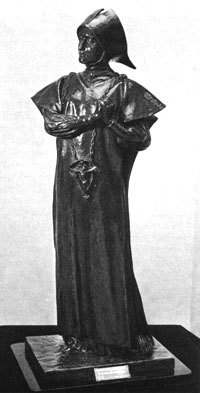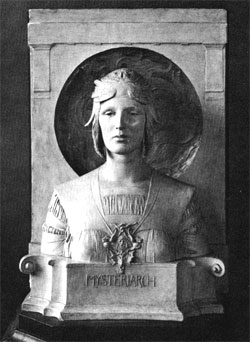John & Katharine Maltwood Collection
| View the Collection |
History of the Collection |
John & Katharine Maltwood |
Information Resources |
Background Maltwoods as Collectors Cultural Context
- Background - Mythology & the Pre-Raphaelites - In England - Arts and Crafts - New Sculpture The Arts and Crafts Movement in Victoria
The Collection Museum at "The Thatch" Notable B.C. Artists in the Maltwood Collection History of the Maltwood Collection (ppt 14.6 MB)
About Us Contact Us Visit Us Site Map

Cultural Context of the Collection - Part 5: New Sculpture | ||||
|
The foundation of the Grosvenor Gallery in 1877 also contributed to the initiation of reforms in British sculpture. This gallery's innovative policy of inviting those artists of every school whom it considered most interesting caused a break from the lingering neo-classical traditions in British art. The work of Burne-Jones, Whistler and Watts were among the main attractions at the gallery. As a result Romantic subject matter, Arthurian and Italianate, was taken over by sculptors and more original and experimental works began to be produced. The result of these developments can be seen in the work of sculptors such as Alfred Gilbert, Hamo Thornycroft, Frederick Pomeroy, George Frampton, Harry Bates, Onslow Ford, William Reynold-Stevens and Gilbert Bayes. The term "New Sculpture" was invented by the critic Edmund Gosse in a series of articles written in 1894 to explain how this stylistic revolution in English sculpture had occurred. Here the main principles of the movement were summed up as naturalism, idealism and symbolism fashioned with a craftsman's awareness.12 In the 1880's Alfred Gilbert became one of the leaders of the "New Sculpture". As well as early works inspired by his study of the Florentine Renaissance, Gilbert later produced literary subjects done in Gothic revival taste. He followed Burne-Jones in creating fantastic figures from some former period of romance and became increasingly concerned with the symbolic aspects of his work. Combinations of materials were used and a new polychromy was achieved by gilding and enamel. These innovations can be seen in works such as his statuettes for the Clarence Memorial in Windsor Castle, 1892-98, where, with sumptuous patterned robes and intricate head-dresses, he stresses the medievalizing character of the Arts and Crafts Movement.
Frederick Pomeroy experimented widely in craft activities and designed many decorative architectural schemes. Reynolds-Stevens was interested in the sinuous forms of Art Nouveau and Mackintosh design. In his Lancelot and the Nestling of 1899, in bronze and ivory, the medieval romanticism has a strongly personal interpretation. This and its companion pieces Guinevere and the Nestling and Guinevere's Redeeming were very successful in England and show the growing interest in subject matter with inherent mysticism. Younger sculptors like Gilbert Bayes joined in with picturesque medieval friezes and figures. His work reveals a mixture of European symbolism and the English Romantic tradition and fits with craft concepts in employing a variety of materials. While Gilbert stressed the revival of craft involvement in sculpture it was George Frampton who was to become the actual leader of the craft sculptors. As Professor of sculpture at the Slade, Frampton is also of interest as a formative influence on Katharine Maltwood's career. Born in London in 1860, he studied at the Lambeth School of Art under W. S. Frith, followed by a period at the Royal Academy Schools from 1881-87. He first exhibited at the Royal Academy in 1884 and in 1887 won a medal and travelling scholarship which he used to study in Paris under Antonin Mercié. Frampton evolved a wide range of techniques and materials including direct carving in stone and wood, metalwork of all kinds, plaster-low-relief, ivory and vellum and combinations of all of these.
The visionary expression of personal dreams and fantasy and the combination of exotic forms and materials gives much of his work a mystical air. For instance the taste of continental Symbolism is seen in his early polychrome bust Mysteriarch, a solemn cult-like object shown at the 1893 Academy and later a success at the Paris Exposition of 1900. This can be seen again in evocative works such as Lamia from 1900 and the Angel of Death, a strange and phantasmal figure, which won a medal at the 1899 Paris Salon. These sympathies with French Symbolism increased Frampton's popularity on the Continent. While most English sculptors submitted their works to the official Salons of Europe, Frampton was almost alone in taking greater interest in the Secessionist movements and exhibited with both the Munich and Vienna Secession and the Libre Esthétique in Brussels. The mysticism and idealism in Frampton's work was accompanied by a formalism based on the designs from nature of Morris and his school. Frampton always maintained strong links with the Arts and Crafts Movement in England and was renowned for his craft-orientated decorative schemes. A pair of silver relief panels Music and Dancing from 1894 reveal his skilful craftsmanship in the intricate detailing of the delicate, flowing forms. Like other members of the "New Sculpture", Frampton also exemplified the search for the ideal in a pre-industrial past. This can be seen in his designs of fantastic armour for a war memorial in 1902 and an earlier statuette of St. George. Seven bronze reliefs representing Heroines from Morte D'Arthur were executed as door panels in 1896 when Katharine Maltwood was his pupil. In 1894 Frampton became joint-principal of the London School of Arts and Crafts and in 1902 Master of the Art Workers' Guild. In recognition of his distinguished career he was knighted in 1908 and served as President of the Royal Society of British Sculpture from 1911-12.
All content on this page is copyright © 7 February, 2006 |
||||

